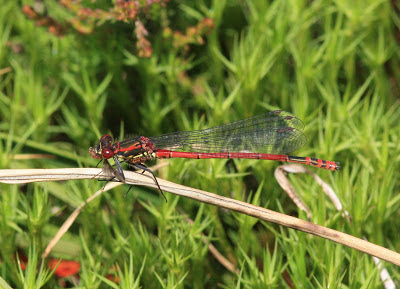The first port of call was the Long Mynd, above Church Stretton, where near Pole Bank there are some water bodies scattered across the top of the hill. We were not sure what to expect, as most years we don't normally venture this way until mid-August. We definitely seemed to be too early for Common Hawker, Common or Black Darter and Emerald Damselfly. However, we weren't too down-hearted, as there were copious quantities of Four-spotted Chasers and a sprinkling of Emperor Dragonflies, whilst the damsels were all busy exhibiting definite breeding behaviour. We witnessed Large Reds, Common Blues and Azures in tandem, the wheel and ovipositing. In fact, it was so hot that the odes were whizzing about like there was no tomorrow, which made photography a bit of a challenge.
There was also a group of Swifts hunting for insects across the top of the heather, approaching so close to us that we could clearly hear their wings as they scythed through the air.
.jpg) |
| Small pool near Pole Cottage, with the Stiperstones ridge visible in the distance. |
We moved on to Wildmoor Pool, a favourite Odonata pilgrimage spot further along the ridge of the Long Mynd. Again there were Emps and 4SCs and plenty of damsels, Our Lass spotting a single Blue-tailed amongst abundant Large Reds and Common Blues. By searching the flowing water above and below the main pools, we also saw a few Golden-ringed Dragonflies, but these were impossible to approach and disappeared off at a great rate of knots whenever we tried. The best sighting was of a familiar face sat by the main pool. Steve Prentice, one of the two British Dragonfly Society's paid employees, was hiking across the Mynd with his partner Ann. This was quite a find, as I've only ever encountered Steve either behind a computer when I have a technical query, or in front of a lecture room screen, holding together the live IT at a BDS function. We didn't know they let him out in the fresh air!
Next, we meandered our way towards Clun, for a potter around this pretty village, before heading off to our accommodation for the evening. Old Downton Lodge is a pleasant mixture of a restaurant with rooms/hotel/B+B, nestled away above the River Teme, just west of Ludlow.
 |
| Our Lass exploring the cottage garden planting in the central courtyard at Downton |
The next day was even hotter and Our Lass was keen for some more garden gazing. I was happy with dragons, so it looked like we needed a garden and some water. Perhaps a water garden would do? Close to Pembridge in Herefordshire, there is Westonbury Mill, with 3 acres of streams, ponds, boggy bits, flower beds, meadow and follies. It was just the ticket.
The follies are an absolute delight. There is a stone tower with an ingenious mechanism for raising water into a reservoir hidden within the structure. Every so often, the tank is emptied through one of the gargoyles half way up the tower.
 |
| The doves don't seem to mind. |
 |
| Reflection in pool set into the floor of the grotto. |
The most recent creation is a cuckoo clock. A fully working cuckoo clock. A cuckoo clock that's really quite large, at least for a... er... cuckoo clock.
 |
| Yep, it's house size! |
You didn't?
Really?
Well listen up anyway, you winged jewel philistines.
There were many damselflies. I mean, very many. Mainly Large Red and Azure, but with the addition of a whole two Blue-tailed. In the streams, were several dozen Beautiful Demoiselles, whose colour variations in the strong sunlight were simply amazing.
 |
| Mr Beautiful Demoiselle |
 |
| Mrs Beautiful Demoiselle |
 |
| Mr and Mrs, he displaying to her. Zingy blue or what?! |
Eventually, the heat took its toll on me and we headed for the dappled shade of the flower beds. In one particular glade, we lingered to enjoy the heady scent of the blooms, the gentle trickling of water across pebbles and the lazy buzz of insects in a patch of sunlight. A sudden movement in the air brought us out of our reverie. A large dragon was hawking to and fro, then landing momentarily on a stem before continuing to hunt again. We both did a double take. A Golden-ringed Dragonfly? In a garden? We normally associate this species with heathland and moors, so this was a pleasant surprise, especially when it finally perched on a piece of vegetation to munch on its prey.
 |
| Wow! |
Another successful hunt brought it ever closer...
And it dawned on me that something wasn't quite right.
Then it caught a bee and settled down to try and chomp its way through all that pollen.
Taking a closer look...
there's damage to at least one of the rear pair of legs, whilst it appears to be only using the middle pair and one of the front pair to grasp the stem. Whether it was using the other front leg to manoeuvre the bee into a better position, I am not sure. Odes will often perch with this pair of legs stowed behind the head, but I've never seen it done singly.
The coating of pollen must have made consuming the bee a tad tricky. I can only possibly liken it to eating a heaped dessert spoon of powdered chocolate. Not that I have tried or would recommend either as a snack.








No comments:
Post a Comment